BY LINCOLN ANDERSON | Updated Fri., Dec. 25, 12:15 a.m.: Along with the year of the pandemic, 2020 has been a year of racial reckoning after George Floyd’s death at the hands of Minneapolis police in May. All across America, from individuals to institutions, there has been a soul searching on issues of racial justice.
In the East Village, at St. Mark’s Church-in-the-Bowery, that process requires grappling with the troubling history of Peter Stuyvesant, the director-general of New Amsterdam, as well as with the very history of the church itself.
The process for St. Mark’s also involves two physical bodies related to Peter Stuyvesant — one of them, in fact, being his actual body. A bronze bust of Stuyvesant sits in the church’s eastern yard, though is owned by New York City. Meanwhile, Stuyvesant’s remains — which, according to the church, cannot be moved, per the will of his last direct descendant — lie entombed beneath the church’s eastern wall.
Stuyvesant, who owned 40 slaves, was the 17th-century Dutch colony’s largest private slaveholder.
His sprawling farm, the Great Bouwerie (“bouwerie” means “farm” in Dutch), stretched from E. Sixth St. to E. 23rd St. It included most of today’s East Village, plus Stuyvesant Town and Peter Cooper Village, as well as the former site of Stuyvesant High School, at E. 16th St. and First Ave. The colonial leader’s house was on what is now Eighth St.
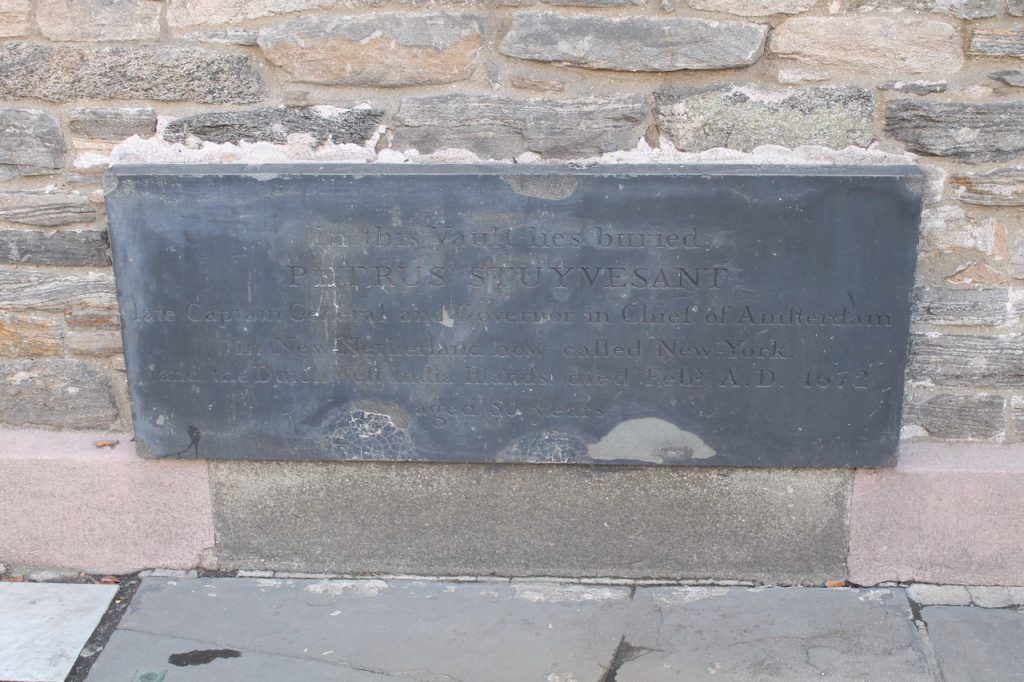
Stuyvesant’s family chapel once stood where St. Mark’s Church is today, along Second Ave. between E. 10th and E. 11th Sts. The chapel, which was Dutch Reform, was razed. The church, which is Anglican, was built on top of the former chapel site. In fact, St. Mark’s Church is the site of the oldest continuous religious worship in New York City.
Through research into slave records and pew seating records, St. Mark’s Church has pieced together some of the names of slaves owned by its early congregation members, as well as of some of the slaves who were manumitted, or freed.
Most of the enslaved persons were from the 1800s or earlier. Two professors at John Jay College of Criminal Justice, Ned Benton and Judy-Lynne Peters, did the research, with help from St. Mark’s Church members Stasia Pasela and Roger Walters. The findings gathered so far are now part of the John Jay New York Slavery Index.
This past January, St. Mark’s posted a temporary memorial in its front yard dedicated to “People Enslaved by Members of the Congregations of the Stuyvesant Chapel and St. Mark’s Church-in-the-Bowery.” A smaller version of this statement is also located just inside the front door. Some kind of permanent memorial is planned but there is no design yet.
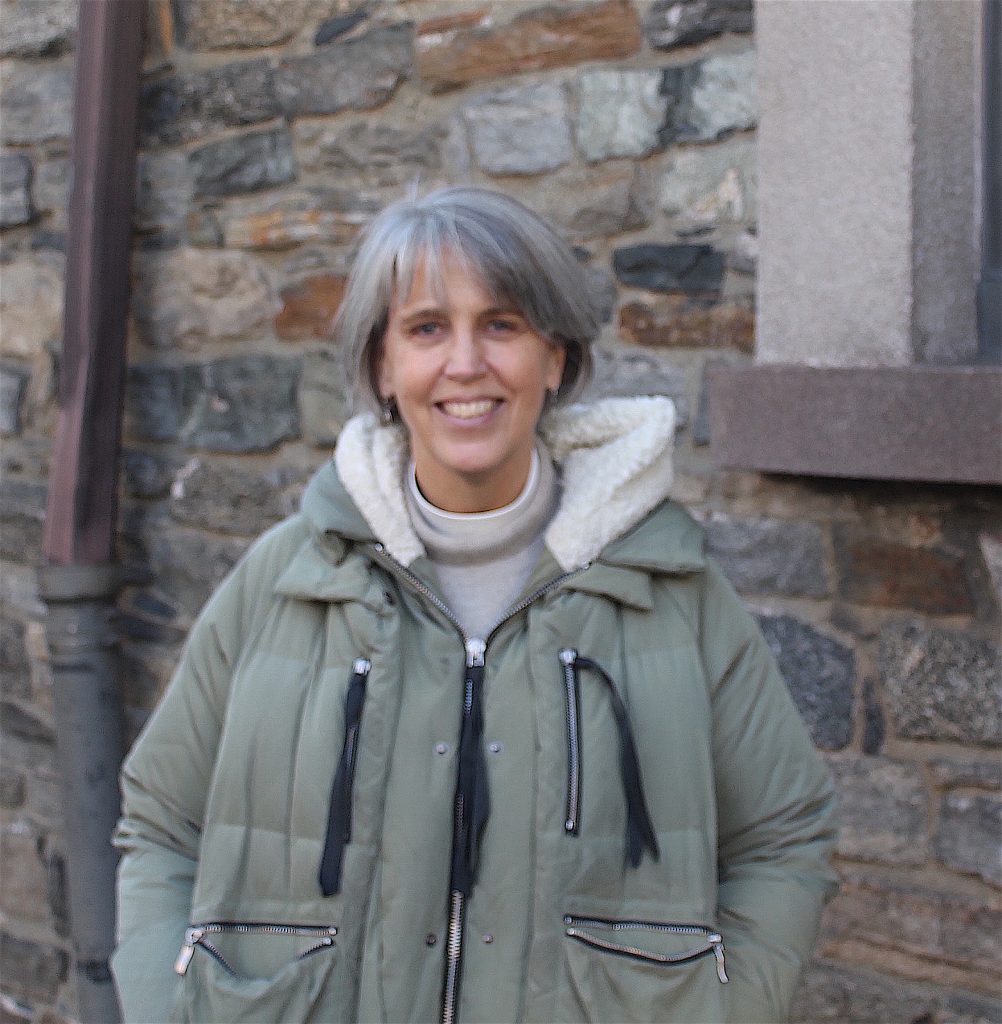
Reverend Anne Sawyer, the 14th rector of St. Mark’s Church, recently met with The Village Sun to discuss the church’s history with slavery, Peter Stuyvesant — both the bust and the body — and what St. Mark’s might do moving ahead, in terms of addressing these issues.
She noted that Peter Stuyvesant’s grandson sold the chapel property to the Episcopal Church in 1793 for $1, “with the stipulation that an Episcopal church be built” to serve the community. The cornerstone of St. Mark’s was laid in 1795 and the completed church was consecrated in 1799.
Meanwhile, Dutch rule of Manhattan had ended more than 100 years earlier when the English took over control of New Netherland in 1674, with the English, in turn, only to be ousted by the American Revolution a century later.
“Alexander Hamilton got the charter for this church,” Sawyer noted. “We have never been Dutch Reform.”
The Stuyvesant family vault is “a remnant of the chapel,” she added.
Along with Peter Stuyvesant, “a few slaves who were like family were buried with him,” Sawyer said. More information about these individuals is apparently not known as of yet.
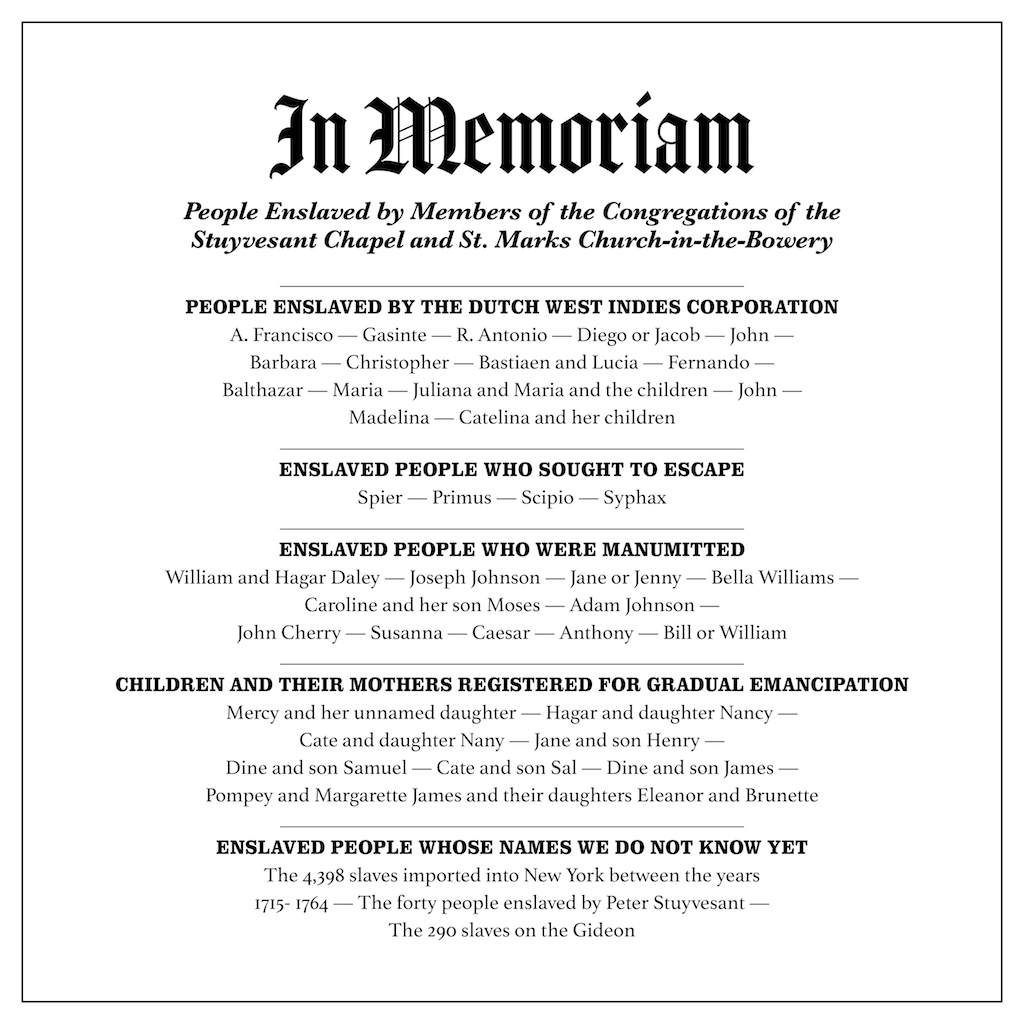
When Augustus Van Horne Stuyvesant Jr., who was described as a bachelor and a recluse, died in the mid-1950s, Peter Stuyvesant’s direct line of the family came to an end.
“Under the will [of Augustus], the vault was sealed,” Sawyer explained. “No one left could open the vault. No one has the authority.”
As a result, the body of the former director-general cannot be exhumed, the reverend said. In other words, it would seem that his remains cannot be relocated.

As for the bust, there are more options.
Sawyer, who comes from Arizona, has been at St. Mark’s three years. But she said the St. Mark’s congregation has had conversations about the Stuyvesant bust “for decades.”
“When we’re not in pandemic, people come daily and visit the statue and his grave,” she noted. “We can move the statue and put it in a museum. Or we can use it to tell a story [about slavery and New York].”
Sawyer noted, for example, that she visited Dachau, where a memorial remains to the former German concentration camp, and that it was a valuable experience for her.
“I’ve been to Dachau. It was so powerful,” she said. “We can erase it, or we can learn form history and tell those stories, accurate stories.”
However, plans for the Stuyvesant sculpture’s relocation might possibly be in the offing, even though this may only be the early stages.
“We’ve already talked to Carlina Rivera about the process of moving the bust,” Sawyer noted, referring to the East Village councilmember. Sawyer said she’s specifically been talking with Pedro Carrillo, Rivera’s chief of staff, and has been assured that “any decision would be made with the church.”
Meanwhile, the church itself continues to confront its past, as she tells it.
“It is absolutely true that members of our congregation owned slaves as prominent members of New York,” Sawyer said, “and that is something that we lament and repent and we are trying to repair the damage that was done.”
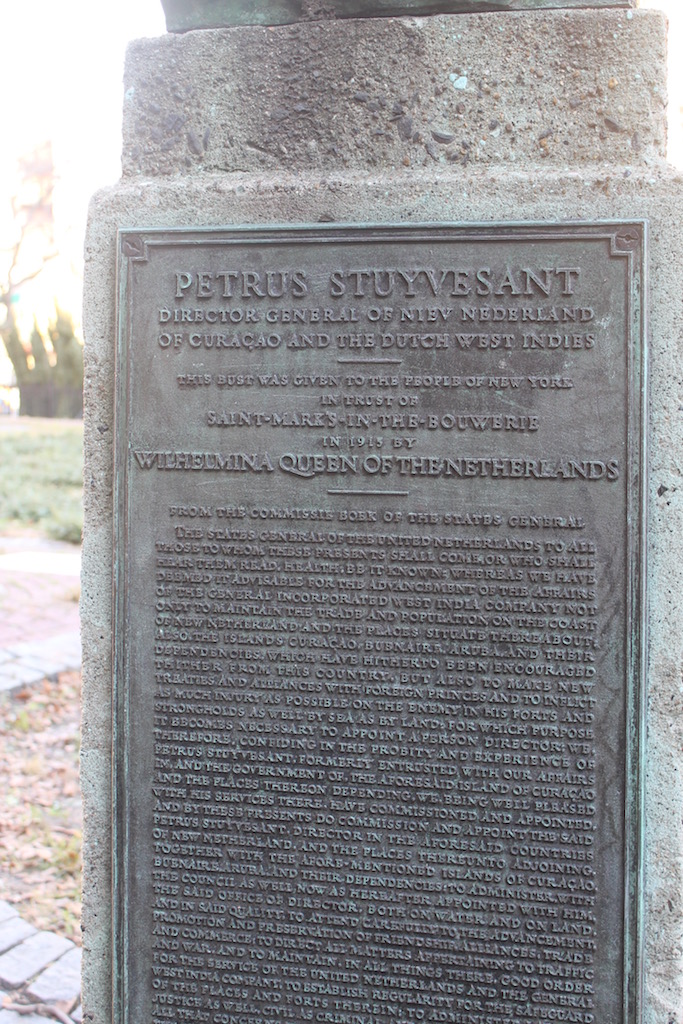
Indeed, in the colonial era, more than 40 percent of European-American households in New York City owned slaves and as many as 20 percent of the city’s residents were slaves.
“We were not unique in that regard,” Sawyer noted of the St. Mark’s congregation in those times.
The church has learned that Stuyvesant did send one slave ship to Africa, the cleric noted.
In 1799, New York State passed a law for gradual abolition of slavery.
“As fellow activists, we stand with our neighbors who have deep concerns about these topics and our history and how to respond to existing statues from parts of our history that were traumatic and created great harm,” Sawyer said.
Injustice also continues today in many forms, she noted, in the mistreatment of immigrants and Native people, mass incarceration and the lack of a minimum wage.
The reverend made a point of mentioning two positive statues of Native Americans — titled “Inspiration” and “Aspiration” — that flank the entranceway to St. Mark’s Church. These were carved by Solon Borglum, the brother of sculptor Gutzon Borglum, who created Mount Rushmore. Sawyer said Solon objected to Gutzon’s Rushmore carving because it did not depict any Native Americans.
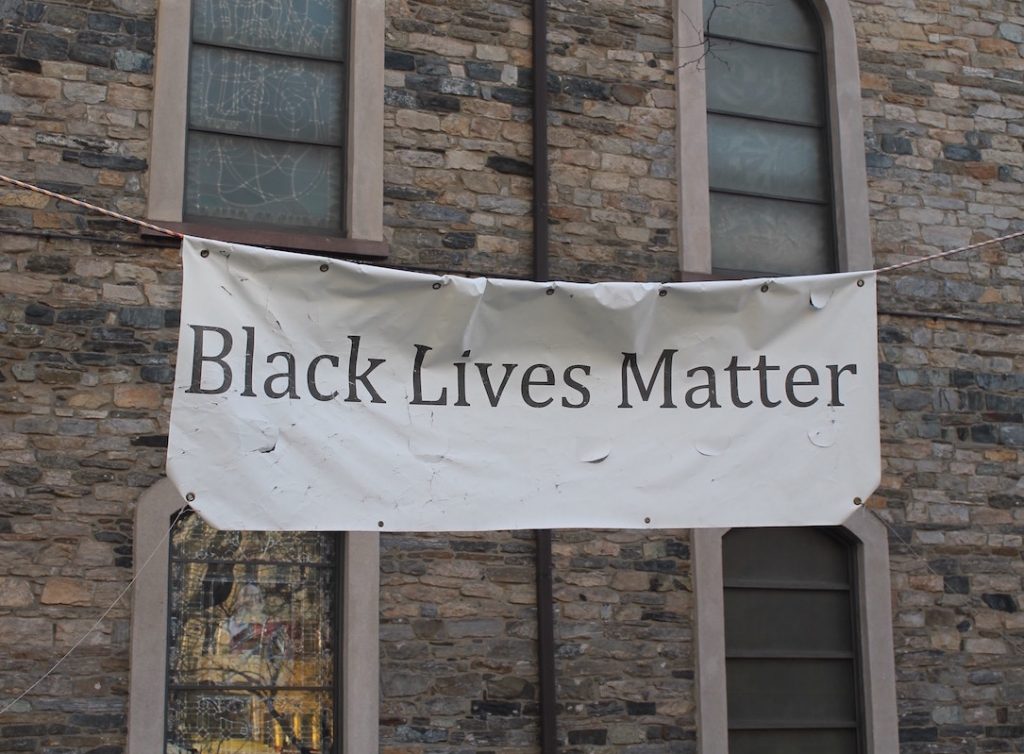
In addition to being involved with slavery, Peter Stuyvesant was also known to be virulently anti-Semitic. He notably tried but failed, for example, to bar Jews who were fleeing from Brazil from settling in New Amsterdam.
At the same time, St. Mark’s also has a long progressive history, the reverend pointed out.
“In the early 1900s, the bishop locked the doors of the church because he felt we were too progressive,” she noted. The rector then was William Guthrie, who embraced the arts and radical ideas for that day, including that dancers should be trained to interpret religion.
In the 1960s, the national Episcopal Church started trying to redress past racial injustice, and St. Mark’s Church was part of this effort. As Sawyer tells it, St. Mark’s sold five or six buildings it owned on E. 10th and E. 11th Sts. Money from those sales was funneled back into the East Village (then still known as the Lower East Side) for community programs. That initiative, the reverend noted, was led by “black and brown members” of St. Mark’s who are still active in the church today as elder members.
St. Mark Church’s Web site now includes a recently added “Racial Justice & Human Rights” section that lays out some of that activist history.
“…[I]n 1969, St. Mark’s was challenged by people of color within its own congregation,” the site says. “That fall members of the Black and Brown Caucus of the church presented a list of demands. These demands included the seating of more Black and Brown people on the church vestry (governing board), the establishment of a Black Arts program to stand beside the existing White arts programs, a demand that the church listen and respond to the needs of Black and Brown people on the Lower East Side, and that St. Mark’s turn over $30,000 to the Caucus to spend as it saw fit. Most of the demands were met, including the turning over of $30,000. From the funds it received, the Caucus worked with members of the Black Panther Party to start a breakfast program and a Black liberation school for children on the LES. The Caucus also opened the first prison law library in New York State. Later, in the 1980s, St. Mark’s trained and hired teens from the LES to work with an architect and professional artisans as they restored the church after the fire of 1978. …
“During the past two years,” the statement continues, “the Episcopal Diocese of New York called all parishes to observe a Year of Lamentation followed by a Year of Apology for its role in the transatlantic slave trade. Together and individually at St. Mark’s, we have lamented. We have repented. (See our prayer to that effect, said in unison at each service.) We are committed to actively owning our history, which is simultaneously beautiful and messy, and reveals a church seeking justice that is also indelibly marked by the sins of slavery and racism. Members of the parish of St. Mark’s participated in chattel slavery. As a parish, we recognize that this is a part of our history. With the help of local historians, we have identified and memorialized by name whenever possible, individuals who were enslaved by past members of St. Mark’s.
“We are now being called to repair the breach which the events of 2020 have once again made stark,” the church’s Web page says. “At the 244th Diocesan Convention in November 2020, our delegates passed a resolution to Remedy the Inequities and Injustices of Racism. We look forward to continuing to uphold this resolution as a community of faith.”
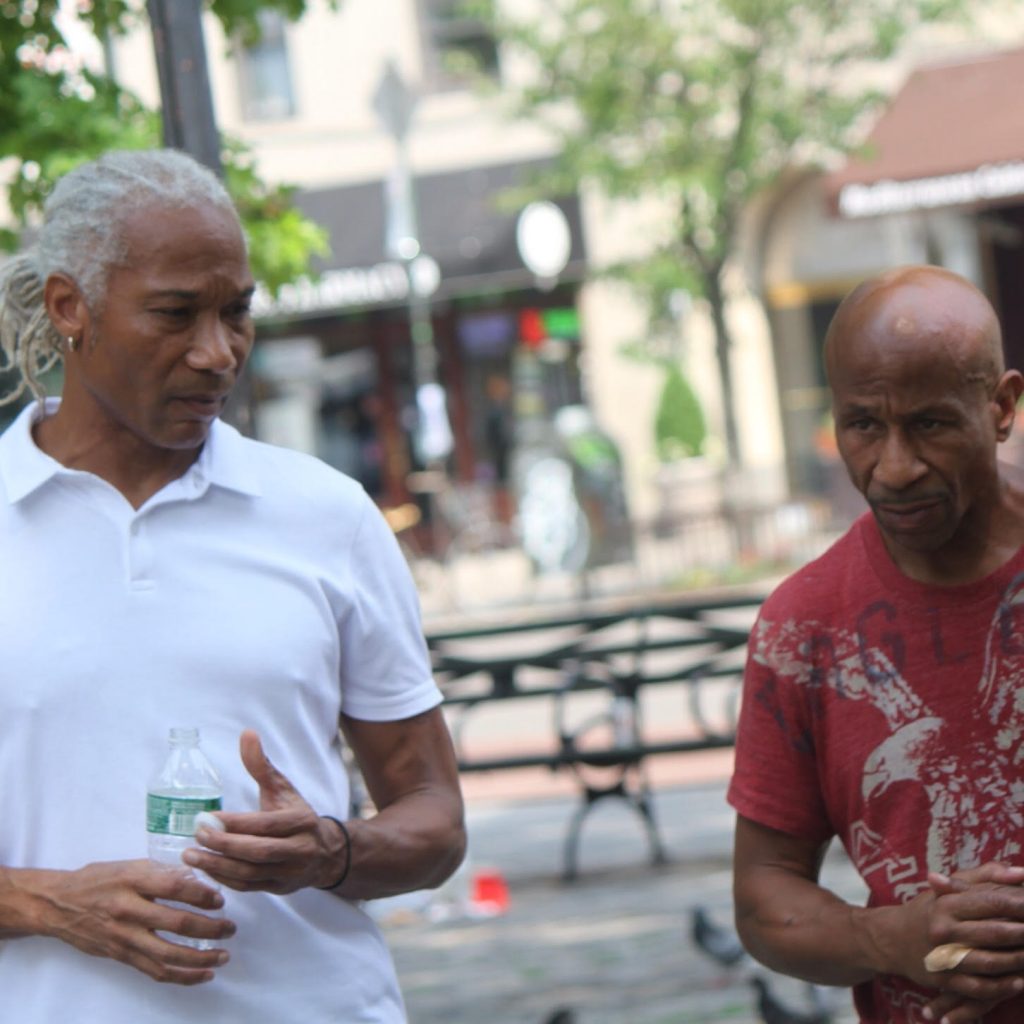
However, a couple of activists charge that the church is not doing nearly enough. Ian David Knife, an artist originally from Zimbabwe who lives in Peter Cooper Village, and Kevin Harris, who grew up in the Baruch Houses on the Lower East Side, say St. Mark’s should divest itself of the house of worship entirely.
Harris said the building ought to become “a center for reconciliation,” with part of it made into a museum and part of the church’s land given to Native Americans.
“I’m saying you’ve got a death camp in the middle of the city,” he said of the St. Mark’s site’s association with slavery, likening it to the Holocaust.
As for the Stuyvesant bust, he said, “They already know they should remove it. … They’re dumping statues into rivers all over. I’m trying to get them ahead of the curve.”
Regarding Stuyvesant’s body, Harris said he doesn’t know how the congregation can even tolerate its presence.
“Do you think I would be in a church praying with this guy below me?” he asked, incredulously.
He said he first got interested in the early history of blacks in Manhattan in 2005, when the African Burial Ground in Lower Manhattan was at risk of being built over for a construction project. He and his brother Troy got involved with the group fighting to protect the site.
“I got educated by them,” he said.
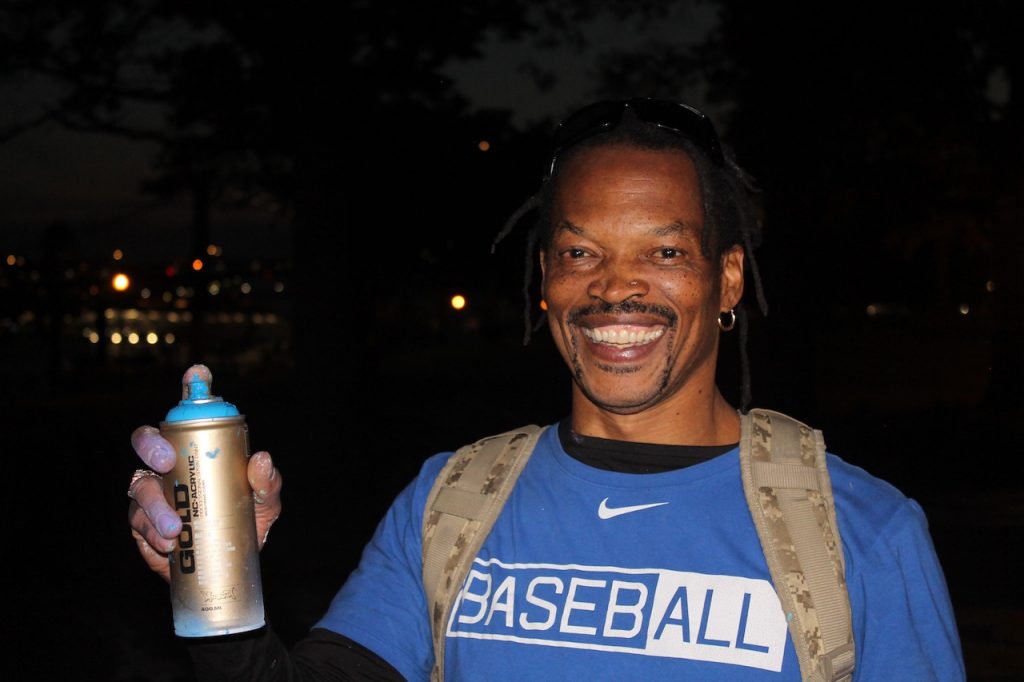
Knife, who is known for his East Village tree-stump carvings, initially took an interest in an effort by Village Preservation (Greenwich Village Society for Historic Preservation) to honor significant sites of early black history in Downtown Manhattan. However, when he found out the idea was only to install plaques, he was disappointed.
Instead, he thought of doing an “art attack” on Stuyvesant St. outside the church. This likely would have somewhat resembled the “art attack” Knife organized at the East River Park amphitheater in October, where paint-wielding artists festooned the band shell with graffiti and art. That effort was intended to block the razing of East River Park for a $1.45 billion coastal-resiliency project.
The idea for Stuyvesant St., as he explained it, was, “Let’s put a painted mural on the street.” It would have contained, among other things, a large seal saying, “New Amsterdam,” he said.
But the church responded that the roadway is actually part of a landmarked district.
“When she heard the word ‘art attack,’ she thought it was molotov cocktails and people throwing things at the church,” Knife said of Sawyer.
Before the Thanksgiving holiday, strange men were reportedly spotted suspiciously hanging around and checking out the church, while using their phones, which caused some concern. As a result, St. Mark’s has been in contact with the East Village’s Ninth Precinct.
Harris, who is currently on the West Coast with family during the pandemic, said he had no idea about any of that. He had, however, reached out to Reverend Al Sharpton’s National Action Network with his complaints about St. Mark’s, so others had been made aware of the situation.
“Ultimately, we would like to see the church shut down and turned into a ‘Museum of Slaves,'” Knife offered. “If not that, then [designate] a section of the church where they put the artifacts.”
He was referring to written records of slavery and other historical items that the church might possibly have access to.
“They really got to make a move and remove that statue,” he said. “Our ancestors were brought here from a kingdom where they roamed.
“We are willing to work with the church as advisers,” Knife said, adding he is not looking for any money.
“As long as I am going to be black in America, this is the agenda,” he stated. “It’s not just trying to cause drama with the church.”
However, there is some drama. At least one local group that Knife is associated with, LUNGS (Loisaida United Neighborhood Gardens), is reportedly concerned about the artist’s rhetoric and the campaign because they “don’t want to hurt the church.”
The brash Knife also claimed that the statement on the church’s Web site was misleading, in saying that St. Mark’s was proactively responding to the struggle for racial justice that has been sweeping the country. Instead, he said, it was pressure from him and Harris that has pushed the church to address these issues.
“It’s not ‘the events of 2020,’ it’s Ian Knife and Kevin Harris that made them wake up,” he declared.
Be that as it may, the idea of transforming St. Mark’s into a museum or a reconciliation center would no doubt be a tough sell.
“We’re dedicated to being a church,” Reverend Sawyer said, with a smile.
She stood in the eastern yard amid a tableau of the location’s “messy history.” Just to her left was Stuyvesant’s tomb; a few feet in front of her, his bust; a dozen feet beyond that, a large Black Lives Matter banner fluttered in the chilly afternoon breeze.
As for creating a memorial at St. Mark’s to the site’s tangled ties with slavery, Sawyer stated, “Our commitment to have a permanent memorial is unwavering.”
She said the memorial process will go on next year and that she could see community members getting involved and having input.

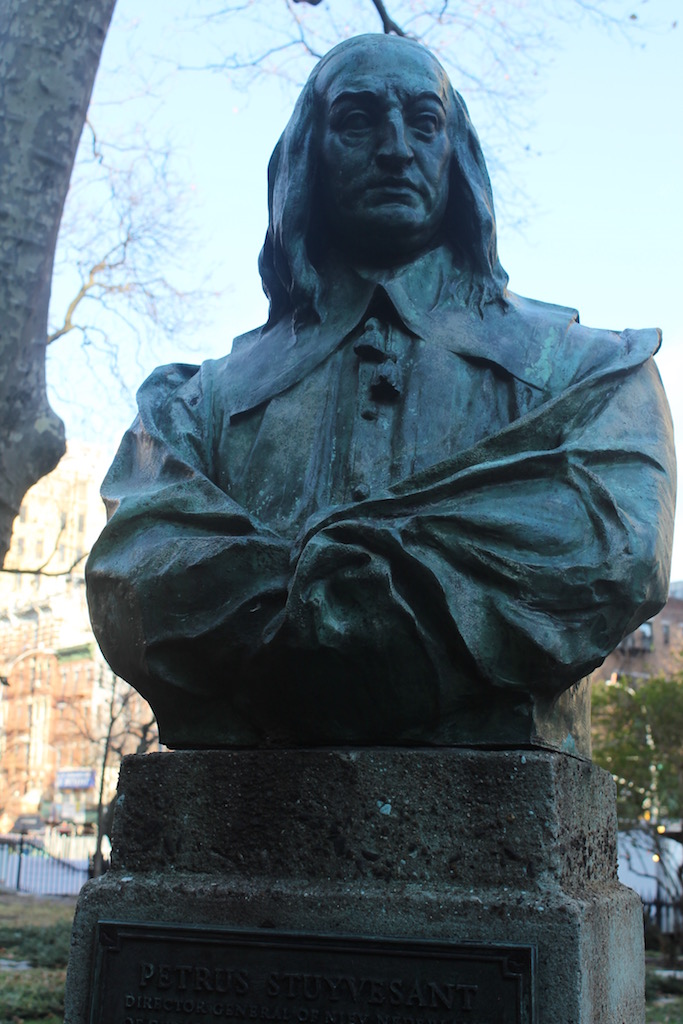
If you come to Saint Marks with hate in your heart because of ghosts of the past. It’s not a community issue it is a personal issue for Kevin Harris and Ian Knife to work out in their personal life. There’s a much kinder history between the Dutch West Indies company and the indentured servitude of both white and black citizens of New Amsterdam! We should address the history of these stories that bring us together, not the gossip history of hate!
I would not like to see St Mark’s closed. They do a lot of good open. As a black person very sympathetic to the activists here, I have to really wonder about who they are talking to. Have they ever attended this church? Maybe they shouldn’t have much say in what happens if they don’t know the church in the way that the people it has served over the years do. Not everything has to be torn down. Germany didn’t tear everything down. They left some things up so people can learn and remember.
We need to keep in mind that the well-known Stuyvesant High School is named after the racist slave owner Peter Stuyvesant. Is this to be tolerated?
It’s so evil to even think that a Slave master and the slave were “friends,” just like a rape victim and the abuser can never be friends, because one has power and control over the other, plus many of the “Favorite” slaves were abused and sodomized by the master. So it’s important that we not speak of slavery as though it was a partnership between the Abductors and the victims.
Interesting history. But was St Mark’s the first Episcopal church built in the city? What about Trinity? Also, I think it was all still the Anglican Church before the War of Indpendence, no?
Bill, you are correct, Trinity was the first Anglican/Episcopal Parish in NYC. Trinity was initially under the British Crown, but St. Mark’s was not. St. Mark’s was born after the American Revolution in 1799, as the first Protestant Episcopal Church in the USA in NYC.
We can’t eliminate actual people from true history while we put up monuments to celebrate the monsters and boogymen. That’s why its important that the church share all the history about the Africans who founded this great Metropolis called New York because, it’s a healing story for all black children to know our history without the story being buffed, polished or suppressed.
Charles NONE of what he published is lies, so chill dude. Do you want me to post the email you sent me?
Below is a copy and paste of the email sent to me by Charles Krezell.
“Ian,
Please take any reference to LUNGS off your RAGS website and any connection with your Art Attack,
LUNGS does not support or condone any of your efforts to confront or endanger St Mark’s Church.”
thank you,
Charles Krezell
LUNGS was not contacted regarding this story. So why is an unattributed quote pertaining to our organization of community gardeners included in this article?
Ian Knife is not associated with LUNGS in any way.